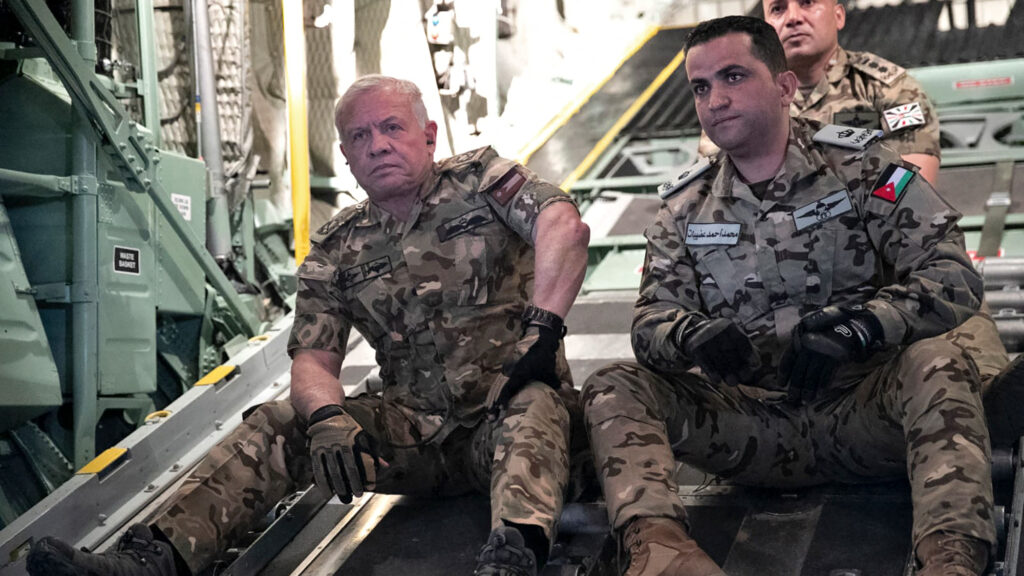Jordanian authorities have profited significantly from overseeing the delivery of international aid into Gaza during Israel’s ongoing war on the besieged Palestinian enclave, Middle East Eye has learned.
Sources say the Jordan Hashemite Charity Organization (JHCO), an official body overseeing humanitarian aid into Gaza, has coordinated with Israeli authorities to act as the sole conduit for aid passing through Jordan.
MEE spoke with sources from international aid organisations and people with direct knowledge of the JHCO’s operations.
One source said much of the aid attributed to the JHCO in fact originates from foreign governments and NGOs, both Jordanian and international, while direct contributions from the Jordanian state are negligible.
Jordanian authorities have demanded $2,200 for every aid truck entering Gaza, according to two NGO sources and two others familiar with the scheme.
New MEE newsletter: Jerusalem Dispatch
Sign up to get the latest insights and analysis on
Israel-Palestine, alongside Turkey Unpacked and other MEE newsletters
The fee, aid organisations were told by the JHCO, is paid directly to the Jordanian Armed Forces.
In addition, Jordan has charged between $200,000 and $400,000 per airdrop over Gaza, the sources said.
Around $200,000 was charged for each random drop, and $400,000 for targeted missions, despite each aircraft carrying the equivalent of less than half a truckload of aid.
Sources said Jordan has expanded its logistical infrastructure in response to rising revenues from the aid operations.
According to MEE’s sources, the kingdom recently acquired 200 new aid trucks through a foreign grant and is building larger UN-supported storage depots in anticipation of increased deliveries under new international arrangements.
Middle East Eye asked the Jordanian foreign ministry, armed forces and the JHCO for comment, but received no response by the time of publication.
Insufficient aid
Since the outbreak of Israel’s war on Gaza, Jordanian leaders have had to navigate growing anti-Israel sentiment at home while maintaining their strategic relationship with the country.
Jordan has a large population descended from Palestinian refugees forced to flee historic Palestine after the mass expulsions in 1948, widely known as the Nakba.
In the war’s early months, mass demonstrations in support of Gaza and Palestinian factions, particularly Hamas, were a regular occurrence across Jordan.
Under mounting domestic pressure, the Jordanian military began airdropping aid into Gaza about a month after the war started and Israel imposed a full siege.
Since then, Jordan has carried out around 400 airdrop operations, some in coordination with other countries, according to the military.

Gaza aid crisis: NGOs fear Israeli crackdown as mass starvation looms
Read More »
King Abdullah II himself took part in at least one of the missions, all of which were pre-arranged with the Israeli military.
The airdrops have faced widespread criticism, including from Gaza residents and humanitarian workers.
They argue that the airdrops, which have in some cases killed or wounded Palestinians, are unsafe, inadequate and unnecessary, particularly when land crossings remain a more viable route for aid delivery.
Jordanian officials also claim to have dispatched at least 140 aid convoys by land since the war began, each carrying multiple truckloads of relief.
These, too, were subject to Israeli approval and coordination before reaching the besieged enclave.
According to Palestinian officials in the Gaza Strip, 500 trucks of supplies were required daily under pre-war conditions, a need that has not been met since Israel’s assault began 19 months ago.
On 9 October 2023 – two days after the Hamas-led assault on Israel – former Israeli defence minister Yoav Gallant, now wanted by the International Criminal Court for alleged war crimes, declared a “complete siege” on Gaza.
Although limited aid and commercial goods trickled in at times, the siege has largely remained intact.
On 2 March, Israel reimposed a total blockade. In the two months since, no aid or goods have entered Gaza, pushing the enclave to what some aid agencies call “catastrophic famine levels”.

